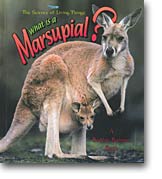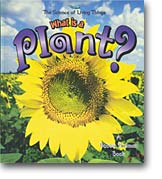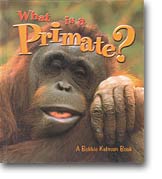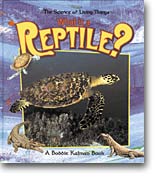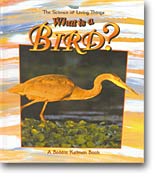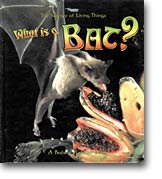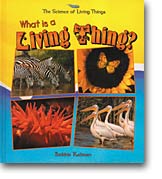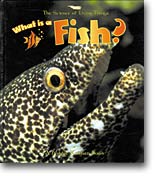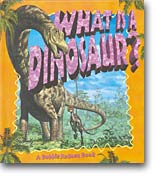|
________________
CM . . . .
Volume VII Number 8 . . . . December 15, 2000
excerpt: A reptile's body is well suited to its environment. If you look at a reptile's feet, you can tell where it lives. Reptiles that live in water have webs between their toes to help them swim. Lizards that climb trees have long toes to grip bark and branches. Burrowing lizards live underground and have sharp claws for digging. Reptiles that live in the desert have long scales sticking out from their toes to help them walk on sand. (From What is a Reptile?)This series offers readers a basic introduction to the plant and animal groups it explores. Covering a minimum of 13 sub-topics, most of them double-page spreads, each title begins with a scientific definition of the featured group. A family tree often follows. In many cases, the book's final page is devoted to environmental concerns regarding the conservation of the species. Text is large and written in short sentences and using fairly simple language. Words highlighted in boldface type appear in the glossary. An index is also included. The strength of this series lies in the outstanding photographs and illustrations. Clear, crisp and colourful, they are sure to appeal to young readers. Cross-sections, diagrams, sketches and cartoon-like drawings add variety. All photos and illustrations are labeled and are well-suited to the text. A tiny diamond border along the top and bottom of each page unifies both the book and the series. These books are especially good for beginning researchers and for kids who experience difficulty reading. What is a Living Thing? This is a particularly good beginning book for youngsters as it introduces them to the concept of living versus non-living things. The larger print and simpler text are indicators that this title is for early readers. A rather unusual feature is the combination picture glossary and index which is designed to help beginning researchers. The book's topics include the differences between plants and animals, what plants and animals need to live, reproduction, growth and change, movement, senses and habitat. What is a Plant? Various types of plants, from the common to the unusual, are discussed. Their adaptation to a number of different environments - underwater, desert, rain forest and tundra - are also featured. Other topics include the parts of a plant and their functions, plant defenses, how plants make and get food, reproduction and life cycle and plants' importance to the ecosystem. Several cross-sections and diagrams serve to clarify some of the main concepts. What is a Marsupial? The special physical adaptations both of common and rare members of the marsupial family are explained as Kalman examines these unique animals from the land down under. One or two pages are devoted to each: kangaroos and their cousins, koalas, wombats, opossums, gliders, bandicoots, bilbies, numbats, marsupial mice, Tasmanian devils, quolls and marsupial moles. Concerns regarding the preservation of marsupials and their habitat are also mentioned. What is a Fish? Due to the fact that humans have only discovered the proverbial "tip of the iceberg" when it comes to ocean life, this title holds special appeal. There are three main groups of fish: bony, cartilaginous and jawless. In this book, Kalman discusses fish bodies, how fish eat, swim and breathe in water, mating and reproduction, the stages in the development of a fish and life in a tropical reef. Of particular interest to students will be the section on defenses, such as warning coloration, poison, countershading and false eyes, the section on unusual fish, like sea horses and sea dragons (whose eggs are carried in the male's pouch until they hatch); and ocean habitats (the shallow sea, the open sea and the deep sea, each of which is home to animals that have remarkably adapted to their surroundings). There is also a section devoted to animals often thought to be fish but that really are not: starfish, jellyfish, crustaceans, dolphins and whales. Highly entertaining and interesting reading! What is a Bird? Once again, Kalman covers the basics. Flightless birds, raptors, water birds, perching birds and ground-dwelling birds are featured. Sections on beaks and feet and their specialized functions help students to understand how birds hunt, eat and move. Types of nests, the art of flying and migration are also covered. What is a Primate? The primate family tree boasts over 200 species which can be divided into two main groups: the prosimians (lemurs, tarsiers, lorises and bush babies) and the anthropoids (humans, apes, monkeys, marmosets and tamarins). Besides the usual topics of habitat and adaptations, this title discusses the ways in which primates communicate by sound, touch and body language. Primates' superior intelligence, when compared to other members of the animal kingdom, has led them to develop a variety of tools and hunting methods which are discussed in this book. Kalman also compares Old World and New World monkeys. What is a Bat? Much maligned by writers of fiction, bats are actually helpful animals that spread pollen and seeds and control insect pests (some species can eat up to 600 in an hour). In addition to the usual fare, Kalman discusses echolocation, roosting habits and how bats raise their pups in nurseries. This book deviates slightly from the norm in that the last page consists of bat jokes and accompanying cartoon-like drawings. What is a Reptile? The four main groups of reptiles are featured here. Lizards and snakes comprise the largest and most varied group; chelonians are all reptiles with shells; crocodilians are represented by over 25 different species of crocodiles and alligators; tuataras are the only members of the last group. Being cold-blooded, reptiles depend greatly on their surroundings for their survival. This delicate balance is well explained. Various means of self-defense are highlighted as well. It is interesting to note that the crocodile qualifies for the Reptile Mother of the Year Award as it is the reptile that looks after its babies the longest. What is a Dinosaur? The book begins with a definition of a dinosaur. Conversely, it tells what isn't a dinosaur (plesiosaurs, ichthyosaurs and pterosaurs were not, as dinosaurs did not live entirely in water, nor could they fly). Kalman talks about the changes which occurred on earth during the various eras, such changes leading to the evolution of the dinosaurs. How paleontologists learn from body fossils (bones, skin and eggs) and trace fossils (the remains of an animal's activities or movements, for example, nests and footprints) in order to piece the past together will be of interest to readers. There are sections devoted to a number of different types of dinosaurs as well as some theories on their extinction. What is a Dog? Covering such topics as a dog's body, types of fur, super senses, pack behaviour, communication and raising the young, this book is sure to please those who consider a dog "man's best friend." There are sections featuring sporting dogs, hounds, terriers, working dogs (those that rescue, haul, guard or pull), herding, non-sporting and toy dogs. A page focusing on problems with puppy mills and breeding will create awareness and spark conversation. Due to the domestication of dogs, Kalman also includes a page on what dogs need to stay healthy and happy. The photos in this book are absolutely adorable. Recommended. Gail Hamilton is a teacher-librarian at Bird's Hill School in East St. Paul, MB.
To comment on this title or this review, send mail to cm@umanitoba.ca.
Copyright © the Manitoba Library Association.
Reproduction for personal use is permitted only if this copyright notice
is maintained. Any other reproduction is prohibited without
permission.
Published by
TABLE OF CONTENTS FOR THIS ISSUE - December 15, 2000.
AUTHORS |
TITLES |
MEDIA REVIEWS |
PROFILES |
BACK ISSUES |
SEARCH |
ORDER |
CMARCHIVE |
HOME
|

